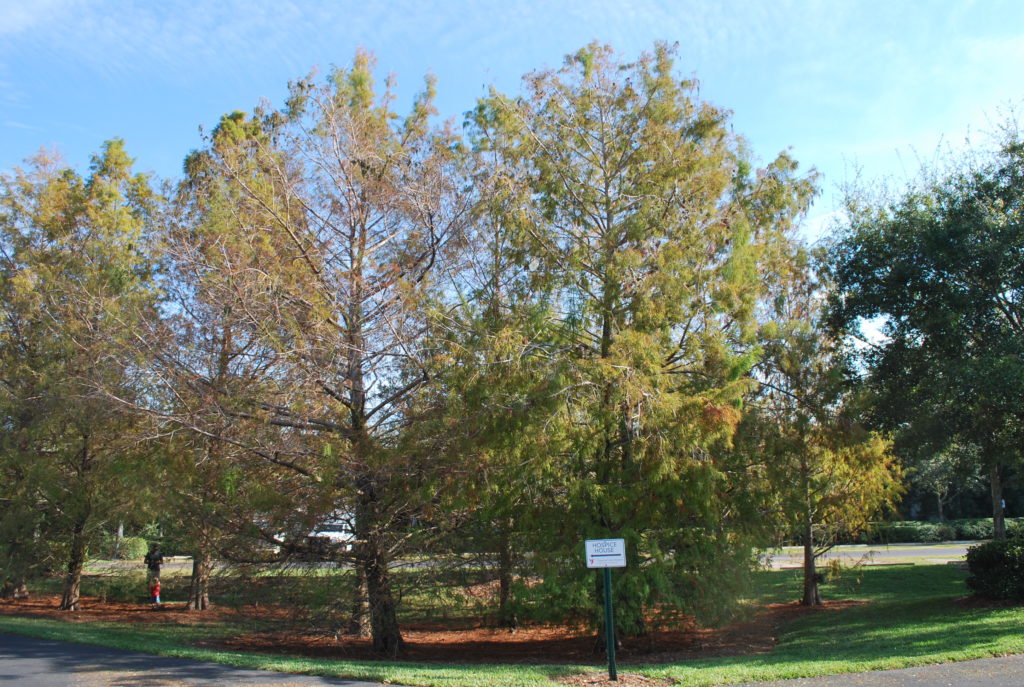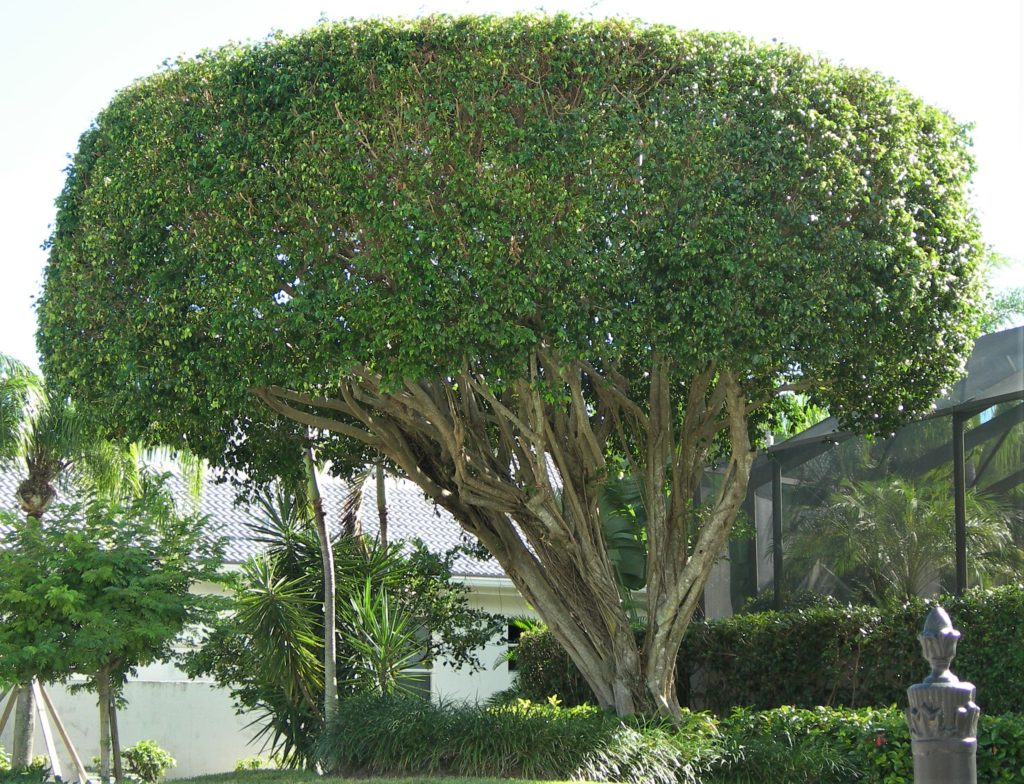For the most part, it is the trees that many gardeners and homeowners worry about during hurricane season, and for a good reason. During recent years, storms from the Gulf Coast through the northeastern US have caused many trees to fail, resulting in millions of dollars in damage to urban areas. Unfortunately, the backlash against trees has resulted in a rash of poor pruning practices. The cry has been cut that tree, it is too tall. Plant and prune trees right for best results during hurricane season.

New residents to Florida may have let the beginning of hurricane season pass without a thought or care. However, for those who have lived in Florida awhile, the onset of hurricane season is something we take seriously and check preparations carefully.
Here is the secret to safe trees during hurricanes; healthy trees, well placed, maintained, and pruned, are the safest. The process begins with selecting a site that will match the trees’ needed growing conditions and that the tree will be planted in the right place. As to proximity to the house, it is recommended that no tree is planted closer than 15 feet to the structure; most trees require more space; consider the average tree height and where it will land if it fails.
Research suggests that correctly pruned trees are more resistant to bending the trunk during high wind events. Work with a certified arborist to determine the proper formative or structural pruning for young trees and mature tree pruning for best wind resistance. However, pruning a tree severely or topping the tree by cutting more than 25% to 30% is not wise and results in a hazardous tree.

If there is a tree near your house that you think is “too tall,” there are several options. The tree can be removed and replanted in a different location and replaced with a smaller maturing species. A good arborist can help prepare for strong winds by thinning the tree. Thinning allows sunlight to penetrate to interior foliage that will help keep interior branches alive. Thinning also increases airflow, and when more air passes through the canopy instead of pushing against it, trees resist storm damage more effectively.
Another arborist tactic for pruning is a canopy reduction. This is a process whereby about 25% of the crown of the tree is removed. The cuts on the branches are precise and leave the tree in a natural form and shape. Crown reductions take time which means they are more expensive, and once the tactic is employed, it should be repeated every year or two. A well-done crown reduction may not be noticeable by an untrained eye, but it results in a smaller, safer tree when combined with proper thinning.
Cutting a tree canopy down so that it is shorter is not a good pruning practice. This procedure is known as topping or hat-racking and creates a whole host of problems for the tree and the surrounding area.
- Topping is stressful to the tree by removing most of the engines (leaves) that support growth. The tree essential starves for many months or years while trying to grow with no leaves to do the work; if there are insufficient reserves to do this work, the tree will weaken and die.
- Topping causes decay in the branches and trunk, leading to cavities or active infections that severely weaken the tree.
- Topping forces the growth of many lateral buds close to the surface of the cut branch. This creates many leafy branches that tend to quickly grow to make a dense, loosely held canopy that is much more susceptible to failure during a storm.
- Topping is ugly; a topped tree will most likely never regain its natural, graceful form.
- Topping is an expensive, high-maintenance procedure, once initiated, will have to be repeated every year.
- Topping reduces property values and is a potential liability. Topping is considered an unacceptable hazardous pruning practice, and any damage caused by failure of a topped tree may lead to a finding of negligence in a court of law.
- Topping is also called “ten-year takedown” because the decline can cause the tree to slowly die.
Preparation for the storms to come is a responsibility not to be taken lightly; well planted and pruned trees are safer during hurricane season.
This article first appeared in the Treasure Coast Newspapers.
There is actually insufficient evidence to prove that pruning our native live oaks protects them from failure in wind events. The UF studies by Gilman used young trees so those results cannot be extrapolated to mature trees. Also there is no science behind the myth that laurel oaks are more prone to disease and death than southern live oaks. The fact that live oaks grow only on the coasts affected by hurricanes and have thrived for centuries without pruning indicates they are designed for wind events without pruning. Unpruned oaks have a natural low center of gravity causing them to be strongly rooted to the ground, and their many small branches and full leafy canopy cushions and prevents large branches from hitting one another in strong winds. Because DNA determines the shape of trees by species, each tree knows where its branches should be in space. Pruning disturbs the balance and structural integrity of our native oaks. Every branch removed results in fewer leaves which is where important benefits to humans occur: oxygen production, carbon uptake, absorption of pollutants from rainwater and toxic chemicals in air, slowing of storm water, shady cooling for our homes, yards and cars (notice where cars are parked in a parking lot!); noise reduction and visual buffering; leaves also create critical habitat for hiding birds and thus, protect them from predators. As we have paid for our large oak canopies to be “thinned” and “reduced”, along with inevitable egregious practices of ” hat-racking”, “lolli-popping” and “lion’s-tailing”, there has been a concomitant documented 40% decrease in birds. In their organic unpruned state, live oaks are the most biodiverse tree in North America due to hosting ~ 300 different species of plants, insects, and other wildlife. Pruning is very costly and creates wounds on the tree that it must heal to escape disease. Pruning branches and therefore removing leaves, causes a tree to not be able to adequately photosynthesize and produce enough sugar to feed itself, nor produce the energy to heal. To try to prevent starvation, oak trees compensate for lost leaves by desperately producing sprouts along their trunks and branches creating very unnatural branches at 90 degree angles with tufts of leaves which arborists want to come back every year to remove, generating a lot of business for themselves. Anyone pruning trees can call themselves an “arborist”. Arborists and their crews are not licensed by any municipality or the State of Florida. The State of Florida will not license the arboriculture industry due to lack of standardized training. A “certified arborist” can be certified by the ISA arboriculture industry self-certifying body with only experience and is not required to have any level of education, not even to have graduated high school. Besides earning a lot of money pruning trees, if a tree becomes diseased or dies due to pruning, they get to remove it for more money and perhaps install a replacement for more money yet again. Tree pruners, whether “certified” or not, have no accountability from anyone. You can never prove they damaged your tree to get your money back. A tree pruner who says they are “licensed” is falsely advertising. Tree pruners may pay a business tax to the municipality but that is not a license. The tree pruning industry is one of the top ten industries for human trafficking and slave labor because of demand by homeowners and associations believing myths that annual routine pruning is necessary to “protect” trees from hurricanes. Save your money and leave your oaks alone, letting them be the beautiful shade trees they were intended to be. Give up trying to grow grass underneath, instead mulch with fallen oak leaves–no need to buy chemically treated and artificially colored mulch. By not pruning, you are helping protect the most important natural land resource in Florida–our native oak trees.
Additional information to my post yesterday: an unpruned oak has a species form of natural upward lift to its branches. Pruned oaks have their structural integrity compromised. Pruned trees’ limbs droop afterward and are more in the way of mowing and over parking lots, than when unpruned. The sole rationale for pruning of native oaks is to raise the canopy off of a man-made structure for clearance. This is accomplished by removing the tips of overhanging limbs instead of “lifting” the entire canopy or “over-raising” with removal of multiple large limbs from the canopy. An iconic picture we do no longer see is the canopies of oaks intertwined along residential roads. It is not necessary to prune trees away from each other. They will accommodate one another’s growth. Also, it is unnecessary to remove every “dead” oak. If the dead appearing oak is inconspicuous and not near a man-made structure, it will be used frequently by wildlife for habitat and perching. Save your money–don’t prune your native oak trees!
Thank you Katherine for providing this information; it is thought-provoking and most definitly different than is currently recommended from past research. Your comments seem to point to the careful placement of trees and different goals for tree management in areas where trees share space with humans. Trees are good and provide all the benefits you list. Do you have links to supporting research-based publications to share with us?
The natural form of live oak is actually dropping branches that hit the ground and grow upwards again. Very few places have trees like this anymore. The Battle of New Orleans pak site has a fairly decent example as do some other old parks in the New Orleans area.
The problem with not pruning the Live Oaks is that they are not planted with their form in mind or in areas with adequate space. So we are left with the problem of do we not plant them because the lack of appropriate space creates problems and just let the species decline even more? Developers and the governing bodies are not moving in a direction that takes these things into consideration. They think only of profit and additional tax base.
The comments about arborists are complete opinion and are akin to prejudice. Like any other profession there are good arborists, bad arborists, and unscrupulous arborists. There is a proof of knowledge required for the certification like any other. But in they end the individual decides to do the right thing or not.
Lastly the property owners and managers make the decisions on the work done. They are almost unanimously lacking in any education about tree biology or care. This leads to decisions based on aesthetics and not safety, health, or biological design. These folks are additionally often instructed by community board members and homeowners who also have no education on these issues.
So many very complicated and difficult issues exist here. Simply blaming arborists or others without contemplating the whole sphere of issues is short sighted and confrontational at best. We all need to work together to find the best solutions for the majority of people to these complicated issues. Otherwise we are just continuing the current my side is right so you should be quiet mentality so pervasive in our communities at present.